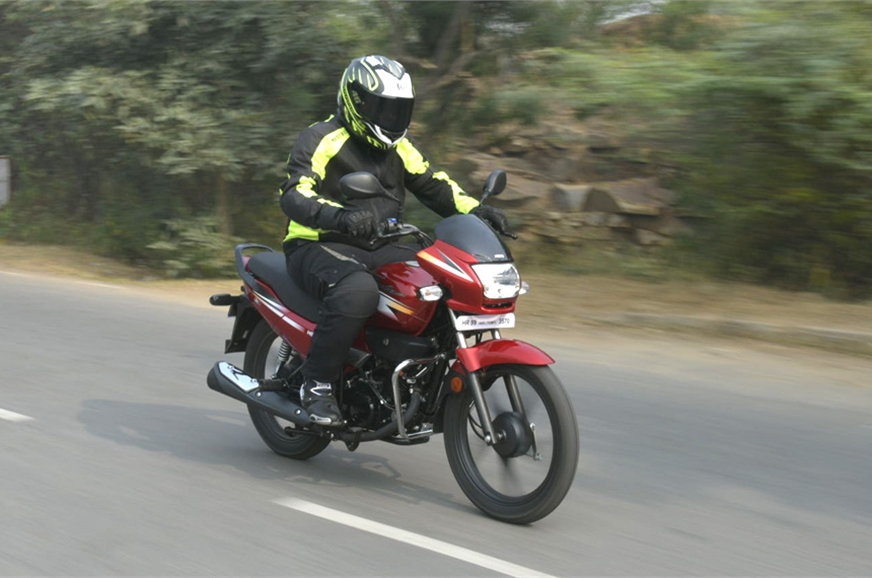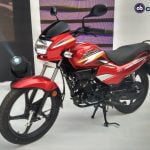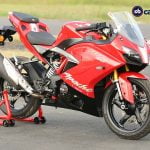
Hero’s popular Splendor iSmart 110 has evolved uncomfortably over the Super Splendor. It doesn’t just looks snazzier and offer the same level of equipment but is also marginally more expensive and powerful (although less torquey). This is a crucial hurdle the Super Splendor had been waiting to overcome – and its turn has finally arrived.
WAIT – A NEW ONE? AGAIN?
Yes! The 2017 Super Splendor used the older-generation sloper engine but the new one gets the fully home-grown 124.7cc motor. This motor has been in our midst since it made an entry into the new Glamour, in 2017 and – for the Super Splendor – it retains its specifcations. This means it produces 11.5hp at 7,500 rpm and 11Nm of torque at 6,000 rpm. Super Splendor fans amongst you will read this as an increment of 1.9hp power and 0.65Nm of torque. Like in the Glamour, the Super Splendor continues with a 4-speed gearbox and also now weighs 124kg – 3kg heavier than the outgoing model.
IS THAT IT? A NEW (OLD) ENGINE?
Not exactly; the SS does get the indigenously-developed non-sloper motor but also gets a few finishing touches, in addition to this.
In sync with the demands of an entry-level 125 customer, the SS gets a mildly sportier-looking seat but one that is firm, reasonably wide and comfortable. The side panels have been revised, too and while it isn’t boxy anymore, Hero has made a conscious decision to not upset the horizontal profile of the motorcycle. Hero knows the commuter market better than you and I know the back of our hands – and the average Indian commuter buyer believes boxier designs and straighter lines represent ruggedness and stability. Moving on, the tail section is slightly more upswept than before and now gets a neatly-integrated LED tail-lamp as well as opposed to the angular, hexagonal unit on the outgoing model.
WHAT’S IT LIKE TO RIDE?
The Super Splendor’s mill feels substantial, especially if you immediately switch over from a 110 (like I did) and, at idle, it’s fairly quiet. Once I got past my struggle with coping with an all-down gearshift pattern, I found myself making decently-paced progress astride it. This isn’t numb-refined as the Honda CB Shine but is relaxed and effortless if you ride it with a gentle throttle hand. Thankfully, I was able to just toe-shift the bike as well; although this didn’t come most naturally. The typical commuter-rider would short-shift through the gearbox and in doing so, the Super Splendor feels happy and in its comfort zone. Going by the analogue speedometer, the SS felt unperturbed being ridden between 50 and 80 kph and the gearing seemed well-suited for low-speed rideability, as well. That being said, you can feel the vibes through the handlebar and pegs if you shift at higher revs.
Hero hasn’t revealed its ARAI tested fuel efficiency figures but even at a low ballpark of 60kpl overall, its 13-litre fuel tank will ensure a range close to 800km – which is seriously impressive. Contributing to its urban efficiency is the i3S (idle-start-stop) system; which kills the engine when you come to a halt and fires it up again when you engage the clutch. This, however, happens only in neutral and not when it’s in gear.
IS IT COMFORTABLE AND SAFE?
To revisit the Splendor range is a tough task for Hero, since it is limited not only by cost-efficiency but also a largely rigid customer mindset. In metal, this translates to a no-nonsense, fill-it, shut-it, forget-it motorcycle that can evolve – but conservatively. In that scheme of things, the Super Splendor ticks most of the right boxes.
The 785mm seat height is bound to be universally comfortable. The upright riding geometry – aided by the (matte-black) handlebar and centre-set footpegs – is never demanding of the rider. Its 124kg kerb weight is similarly inoffensive, although it is heavier than its primary rivals, the Honda CB Shine (123kg for the top variant with a disc brake and CBS) and the Bajaj Discover 125 (120.5kg, drum variant). It is, however, lighter than the Bajaj V12 (133kg, drum variant).
Hero will not offer a disc brake on the Super Splendor, even as an option (for now, at least) and while it gets 18-inch alloys as standard, it doesn’t get tubeless tyres. I wish it did because I don’t see any customer opting for the hassle of fixing a puncture on a tubed tyre; it’s clearly a cost-driven decision, then. The 130mm drum brakes on the bike are progressive but naturally lack the bite and feel of its disc-equipped rivals. A CBS (Combi-brake System) would have been a thoughtful add-on, but Hero is going to wait for it to become the norm (in 2019) before it heads in that direction.
VERDICT
Hero will officially launch the Super Splendor only in January 2018 and while the update won’t reposition it, the bike will demand an increment for the revised engine specs and features. At present, the Super Splendor retails for Rs 52,468 (ex-showroom, Mumbai), while its similar-spec (self-start, drum brakes, alloys) contemporaries are priced at Rs 59,801 (New Glamour), Rs 57,804 (CB Shine), Rs 53,491 (Discover) and Rs 57,843 (Bajaj V12). Going by this, we expect the Super Splendor to be priced at Rs 56,000, since this will keep it clear of the New Glamour’s pricing and also undercut its rivals.
To summarise, the Super Splendor is a basic, no-nonsense motorcycle that will easily find takers for being solid, comfortable and hassle-free. That said, it’s not ahead of the game in any way and is less tempting than the better-equipped and smoother Honda CB Shine.
[“Source-autocarindia”]





